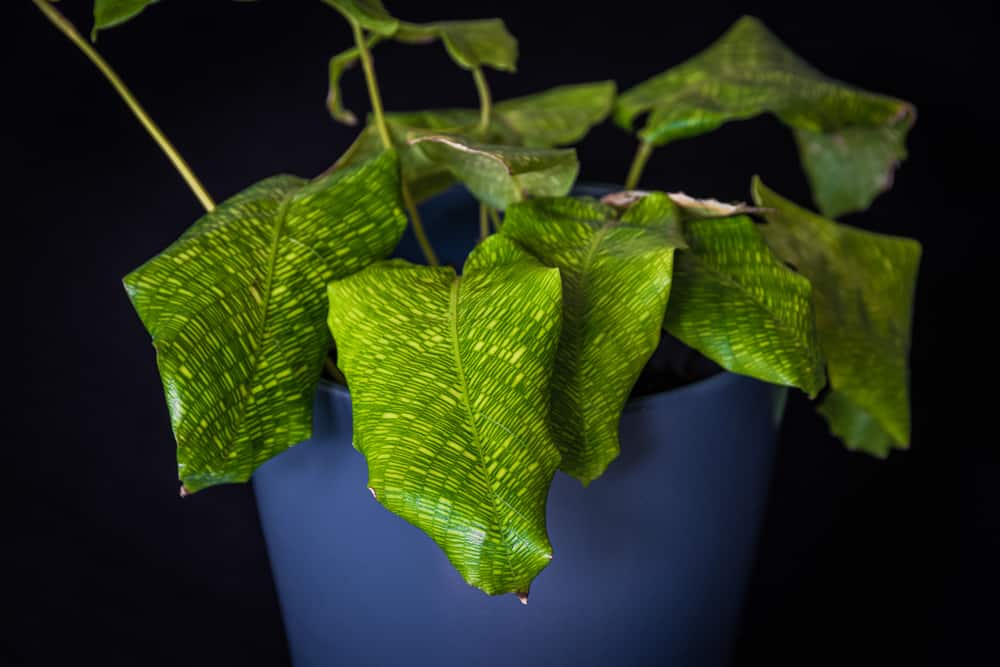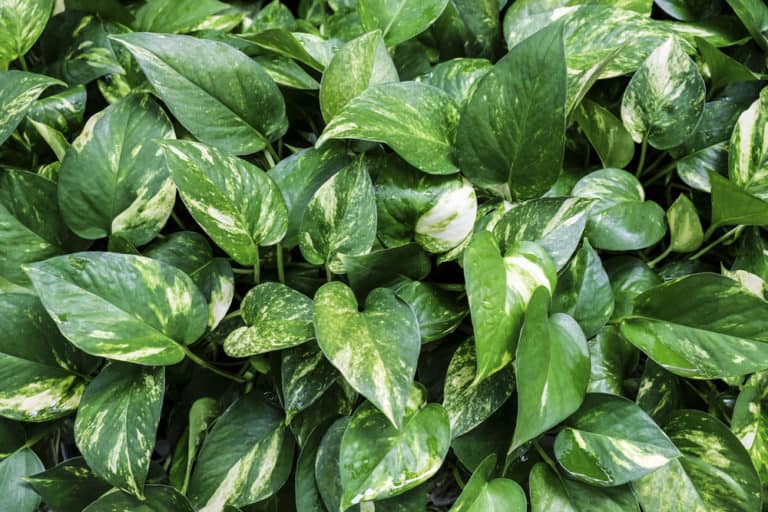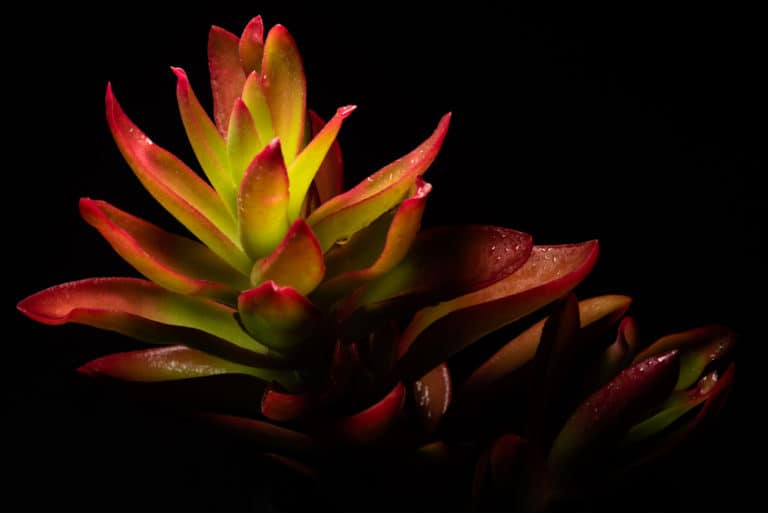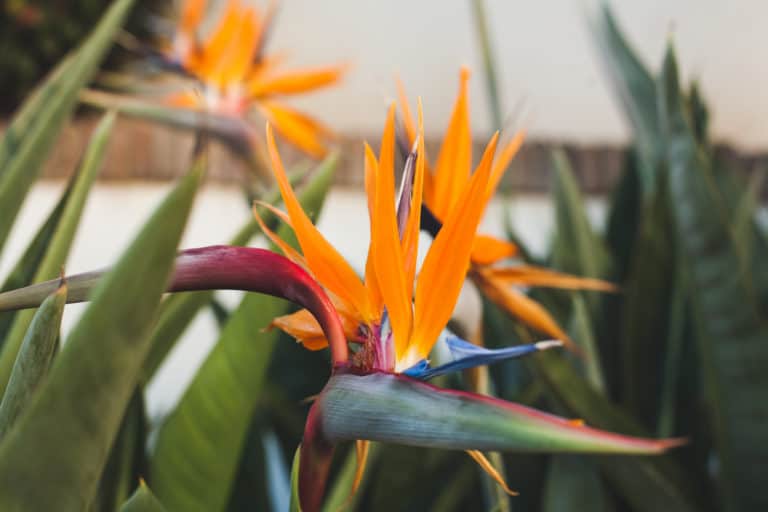Goeppertia Kegeljanii ‘Calathea Musaica’ Care Guide (2024)

Calathea musaica is one of those plants that has undergone a name change in recent years.
Its official name is now Goeppertia kegeljanii, as it has been reclassified, but most people still refer to it by its old name, or its common name Calathea network.
Whatever you call it, the gorgeous mosaic-patterned leaves make this tropical plant a winner.
| Scientific Name | Goeppertia kegeljanii |
| Common Name | Calathea Network, Calathea Musaica, Calathea Bella |
| Light | Bright indirect sunlight |
| Watering | Water if top inch of soil is dry |
| Temperature | 65 to 85ºF (18 to 30ºC) |
| Hardiness Zone | 10 to 12 |
| Humidity | 60 to 80% |
| Soil Type | Rich, quick-draining, loamy |
| Soil pH | 6 to 7.5 (mildly acidic to neutral) |
| Fertilizing | A balanced feed once a month in spring and summer |
| Repotting | Every 2 to 3 years |
| Pruning | Only to remove dead foliage |
| Propagation | Division |
| Toxicity | Not toxic to humans and pets |
| Mature Size | 24 inches asa houseplant |
| Bloom Time | Rarely blooms indoors |
What’s Unique About Calathea Musaica?
The Calathea musaica plant is native to the Atlantic Forest that stretches along the east coast of Brazil, a tropical rainforest with an amazing diversity of plant and animal species. In 1875 it was found there by the plant explorer William Bull.
Almost 150 years later, it’s become one of the trendy must-haves of the 2020’s. All you have to do is check on Instagram to see how popular it has become.
Calathea musaica plants are especially prized for their large, glossy leaves’ unique, intricate pattern similar to a mosaic, which is what “musaica” means.
Growing Calathea musaica can be a little challenging, but its gorgeous leaves make it worth the effort for an experienced indoor gardener.
Calathea Musaica Care
In the tropical rainforests where Calathea musaica originates, it grows as an understory plant on the forest floor.
You need to understand its native environment to provide good Calathea musaica plant care.
Your Calathea network care should focus on a bright location with warm temperatures, high humidity, and consistently moist soil.
Light
In its native Atlantic Forest, Calathea musaica grows beneath the tree canopy which filters the hot tropical sun, creating a dappled light environment.
As a result, Calathea musaica light requirements in your home are for bright, indirect light, or between 10,000 to 20,000 lux.
If you have a north or east-facing window, you’ve got the perfect place to meet your Calathea network light needs in summer. However, in winter you may need to find a brighter spot for it in a room with a south or west exposure.
No matter what time of the year, keep it out of the full sun, which will fade or even scorch Calathea musaica’s delicate leaves.
If you have no option but a south-facing room, set it several feet back from the window.
Watering
The Atlantic Forest has a seasonal rain pattern, with summer being wetter than winter, but on average, rain falls every 3 to 5 days all year.
As might be expected, Calathea musaica watering needs to be done regularly to keep the soil moist at all times.
You should water Calathea network whenever the top inch or so of the soil has dried out. Gently pour tepid water across the entire surface until it has been absorbed evenly and excess water starts to dribble out the bottom.
Calathea musaica’s watering needs are best met with rain water or filtered water. If you must use tap water, let it sit in an uncovered container to give the fluoride and chlorine a chance to dissipate.
Temperature
The native habitat of Calathea musaica may be one of the coolest in Brazil, but it is definitely still tropical.
Daily average highs range from 81 to 90ºF (27 to 32ºC), with lows never dipping below 65ºF (18ºC).
The recommended Calathea musaica temperature range reflects this, running from 65 to 85ºF (18 to 30ºC).
Basically, any temperature that you will feel comfortable at is a good temperature for Calathea network. If you want to give it a spell of really high temperatures, move it outdoors to a shady spot in the hot summer months.
The lowest that its temperature tolerance will take is 60ºF (15ºC). Anything below that will halt growth and damage the leaves.
It has no frost hardiness at all, so it needs to come back in by late summer.
Humidity
No matter what time of the year it is, the relative humidity in the Atlantic Forest hovers around a uniformly high 70 to 80%.
Calathea musaica humidity requirements are not much lower than that in your home. The ideal humidity for Calathea network is between 60 to 80%.
Otherwise, your Calathea musaica will develop curling leaves with brown tips and edges, and nobody wants to see that.
To raise the humidity level around your Calathea network, start by grouping your moisture-loving plants together, as that can help create a moister microclimate.
However, that’s not going to be enough, and misting the foliage is time-consuming, only temporary, and can foster fungal and bacterial disease.
The best long-term solution for all your plants is to buy a small humidifier.
Soil
Calathea musaica soil needs to accomplish a couple of seemingly contradictory goals at the same time: drain off excess water, and retain moisture.
The recommended pH level for Calathea network is 6.0 to 7.5, or mildly acidic to neutral.
Where it grows on the forest floor, it’s used to a spongy, well-draining soil with plenty of rotting organic matter.
You can make a good soil for Calathea network from two parts peat moss or coco coir and one part orchid bark. You can also add a generous handful of well-rotted compost or worm castings for extra nutrients in the soil mix.
Fertilizer
If you added compost to the soil when potting up your Calathea musaica, you won’t need to use any additional Calathea musaica fertilizer for at least the first year.
However, you will otherwise need to use fertilizer for Calathea network to keep it growing happily.
A standard houseplant liquid fertilizer with a balanced fertilizer ratio of 20-20-20 will work well.
Just dilute it to half the recommended strength and pour it over the whole soil surface to ensure even distribution to the roots.
Do this once a month in spring and summer, stopping in fall and winter when your Calathea musaica enters its dormant state.
Potting & Repotting
Calathea musaica repotting should be done every 2 or 3 years, when you see that it is becoming rootbound. Look for roots growing out of the drainage holes, or filling up the pot.
When repotting Calathea network, choose a pot size one step up from the current one. A plastic or glazed pot will help keep the soil moist longer, while drainage holes will let excess water drain so that the roots can breathe.
It’s important to always use fresh potting soil. Not only will the nutrients in the old soil be depleted, but there may be a build-up of fertilizer salts and disease pathogens.
Pruning
Calathea musaica pruning is only recommended to cut away dead or damaged leaves, whenever they occur during the year.
Not only do they detract from your precious plant’s appearance, but they also can be a vector for disease and pests.
When cutting Calathea network leaves, use sharp, sterilized scissors to cut the stems right at the soil level.
You may have brown leaf tips or margins while the rest of the leaf is still in good shape. In that case, use small, very sharp scissors to carefully trim off the brown bits. That will restore the leaf to its previous great appearance.
Propagation
Calathea musaica propagation can only be done by root division.
It’s best to wait until you have to repot your Calathea musaica, to minimize trauma to the roots. Early spring is the best time to do it.
To propagate Calathea network, pull the root ball out of its pot, and carefully clear off as much of the soil as possible.
You should see separate Calathea musaica plants entwined together. Gently pull apart the clumps, only using a sharp sterilized knife if necessary.
Pot up each new plant in its own container, and water thoroughly to help them settle into their new home.
You can expect that it will take a month or more for the divided plants to recover sufficiently to start new growth.
Also, make sure to check out our in-depth Calathea ornata plant care guide.
Common Problems of Calathea Musaica
Most Calathea musaica problems are simply the result of poor growing conditions for this tropical plant.
However, even the best gardeners may experience some problems with Calathea network. The key to solving problems is to catch them early before serious damage is caused.
Your best indicator that something is wrong is always the leaves, as they will show the first signs of distress.
Pests
The most likely Calathea musaica pests include many of the common indoor houseplant bugs.
To protect your Calathea network from attack, try using monthly sprays of a neem oil or insecticidal soap solution to ward off invaders.
Spider mites are more likely to spin their webs when the humidity around your Calathea musaica is low. They can easily be rinsed off in the shower or sink.
Mealybugs can usually be found gathering in fuzzy clumps on the underside of the leaves. Wipe them off with an alcohol-soaked cotton ball.
Fungus gnats love moist soil, and buzz around the plant. Use yellow sticky traps to catch the adults, and kill the larva by drenching the soil with a hydrogen peroxide and water solution.
Diseases
There aren’t a lot of potential Calathea musaica diseases, and most of them get their start with poor watering practices.
Your Calathea network may develop yellow leaves and soft stems, with roots turning black and foul-smelling. This is root rot, a fungal disease that can flourish when the soil is too wet.
You can try to save your Calathea musaica by cutting off the infected parts, and replanting it in a new pot with fresh, porous soil.
White mold may cover the surface of the soil if air circulation is poor. Scrape every bit of the stuff off, and try placing a fan nearby to move the air around better.
Growing Problems
Other growing problems are symptoms of poor care of your Calathea musaica. In other words, to cure your sick plant, pay attention to its symptoms, as it’s telling you what needs to change.
Brown leaf tips may mean that the humidity is too low. It might also mean that you’re using too much fertilizer, or that the chemicals in tap water are damaging your Calathea musaica.
Drooping leaves on the Calathea Musaica may indicate that you’re watering too much or not enough. Or that it’s getting too much or not enough light.
Yellow leaves may be a sign of overwatering, under-fertilizing, or not enough light.
Toxicity of Calathea Musaica
Calathea network is not at all toxic to humans or animals.
In fact, it’s closely related to the arrowroot plant, which is used to make flour.
Because it has no toxicity, it can be safely grown in a home with children and pets, but you should still try to keep the small members of your household away from it.
For Humans
Because Calathea musaica is not toxic to humans, you do not have to take any precautions against exposure to the sap or foliage while handling the plant.
However, you should still try to keep your children away from your Calathea network.
The delicate leaves of this plant will not withstand any rough handling, and that’s what children are best at.
As well, if you have used any insecticides or fertilizers on your Calathea musaica, you will not want your children exposed to them, even if they are organic.
And finally, while Calathea network is safe, many other tropical plants are not, and a toddler will not understand why one is off-limits and another is not.
For all these reasons, a blanket policy that plants are not for touching should be instituted.
For Pets
None of your pets will be put into a life-threatening situation by ingesting the foliage of Calathea musaica.
However, that does not mean that they cannot have a temporary adverse outcome if they eat some leaves.
Cats and dogs are both the descendants of wild species that evolved as carnivores, so their digestive systems are better at dealing with meat than vegetables.
If your cat or dog eats too much of your Calathea musaica, it may end up with a gastro-intestinal upset causing vomiting and diarrhea.
You and they will be much better off if your plants are kept somewhere inaccessible to your furry friends.
Calathea Musaica Appearance
Go to Instagram and you will be in no doubt that the Calathea musaica appearance is much admired, and with good reason.
The unique mosaic pattern that covers the delicate leaves of the Calathea network plant looks remarkably fresh and modern.
Its compact size makes it perfect for even small city apartments where the refreshing presence of green plants can add so much.
Foliage
The foliage of Calathea musaica is unlike anything else.
Each leaf has an absolutely fascinating all-over pattern of small rectangular shapes, fanning out in diagonal rows from the center rib. It almost looks like someone took a dark green pen and hand-drew short lines to divide them into glossy mosaic tiles.
They are two-tone bright green and dark green on top, with yellow-green underneath.
Because the leaves are thin and papery, you will see the pattern come luminously alive when light shines through them.
The oval leaves have a pointed tip and are about 8 inches long and 5 inches wide.
Flowering
The Calathea network flower is much less impressive than the intricately patterned leaves of this tropical plant.
As well, Calathea musaica flowering is unlikely to occur on plants grown indoors, no matter how much you encourage them.
Blooming usually happens only in its rainforest habitat, and you simply cannot replicate those exact conditions in your home.
It’s not a big loss, anyway, as the white, tubular, short-lived flowers are mostly hidden under the larger, taller leaves. They don’t even have a fragrance to increase their desirability for the home gardener.
Instead, enjoy the year-round show that the fascinating leaves provide.
Size and Growth
The full size of Calathea musaica grown indoors as a potted plant is about 2 feet tall with a 2 to 3 foot spread.
It has a moderate growth rate and may take five years to reach its mature size.
It does not develop a central stalk; instead, the individual leaf stems sprout from the underground rhizomes, creating a full, bushy look.
Calathea musaica, like all members of the Marantaceae family, have the charming habit of folding their leaves up at night as the light dims. They then open up again in the morning light.
Because they follow the light so much, you should regularly give your Calathea musaica’s pot a quarter turn to keep it growing evenly.
Calathea Musaica Fragrance
There is no Calathea musaica fragrance; not even the rarely-seen flowers have a scent associated with them.
However, that does not mean that Calathea musaica does not improve your home’s atmosphere. It is known to be an effective air purifier, filtering toxins such as formaldehyde that are commonly used in household items such as carpeting.
As well, a plant that has no fragrance, pleasant or otherwise, is preferable for planting in locations where people with allergies to strong fragrances might be exposed to them.
Even in your own home, you may not want to deal with a scent that could be overpowering in a small space.
Suggested Uses for Calathea Musaica
One of the reasons that Calathea musaica is such a popular plant right now is because its abstract, detailed pattern and fresh, clean colors fit perfectly into modern decor.
As long as you can provide it with its essential growing conditions indoors, you can find a variety of spots around your home to use this unique plant.
Since it loves extra humidity, let it soak up the moist air in your bathroom, or perch it atop a kitchen cabinet to brighten up your workspace.
It’s an excellent foil for flowering plants in a large grouping. However, it is equally well-suited to being displayed on its own on a mantlepiece or table where its unique design can be appreciated.
FAQ
What is Calathea musaica?
Calathea musaica is a tropical rainforest perennial native to the Atlantic Forest of south-east Brazil, where it grows as an understory plant on the forest floor.
How to identify Calathea musaica?
Calathea musaica has oval leaves with an intricate pattern similar to mosaic tiles or binary code. They are in shades of dark and bright green and grow to 8 inches long.
How to care for Calathea musaica?
Calathea musaica should be grown in rich, porous soil, and kept in bright but indirect light at warm temperatures and with high humidity, with frequent light watering.
How to grow Calathea musaica indoors?
Calathea musaica can be grown indoors as a potted plant, as long as it gets regular watering and light fertilization, while in a warm and humid environment.
How to grow Calathea musaica outdoors?
Calathea musaica can be grown outdoors in zones 10 to 12 as either a container plant or as a landscape plant, in a shady location to protect it from the direct sun.
How fast does Calathea musaica grow?
Calathea musaica has a moderate to slow growth rate, taking as long as 5 years to reach its mature height of 2 feet when grown indoors.
How tall does Calathea musaica grow?
Calathea musaica usually reaches a mature size of 2 feet tall with a 2 to 3 foot spread when grown indoors as a potted plant.
How to make Calathea musaica grow faster?
Calathea musaica can grow its fastest when it gets the optimum conditions of warm temperatures, very high humidity, regular watering, and bright light but no direct sun.
How to stake Calathea musaica?
Calathea musaica stems naturally grow stiff and upright, so they have no need for the support of a stake or trellis. You should rotate the pot a quarter turn once a week.
How to pot Calathea musaica?
Calathea musaica should be planted in rich soil with plenty of organic matter, and that drains well, in a glazed or plastic pot to prevent the soil from drying out.
How to revive Calathea musaica?
If your Calathea musaica’s soil has dried out but the leaves do not yet appear dead, try rescuing it by plunging the pot into a pail of tepid water.
Why is my Calathea musaica dying?
Your Calathea musaica may have developed root rot as a result of overwatering. Cut away all the parts that have suffered damage, and replant it in fresh, porous soil.
Why is my Calathea musaica drooping?
Your Calathea musaica may be overwatered, underwatered, too cold, in too dark a spot, or is getting too much light. Evaluate its current situation to determine the most likely cause.
How cold can Calathea musaica tolerate?
Calathea musaica prefers to grow at 65 to 85ºF (18 to 30ºC), and temperatures any lower than 60ºF (15ºC) will halt its growth, while frost will kill it.
How to get rid of pests on Calathea musaica?
Calathea musaica pests can usually be deterred by spraying all the leaves, top and bottom, with an insecticidal soap or neem oil solution every month.
Is Calathea musaica toxic to cats?
No, Calathea musaica is not toxic to cats. However, cats are carnivores who have difficulty digesting vegetative matter, so they may have diarrhea and vomiting if they eat it.
Is Calathea musaica toxic to dogs?
No, Calathea musaica is not toxic to dogs. However, dogs are primarily meat eaters who cannot handle a lot of plant material, so they may end up in gastrointestinal distress after eating foliage.
Is Calathea musaica toxic to children?
No, Calathea musaica is not toxic to children. However, children should not handle plants that may have insecticide and fertilizer residue, so keep them away.
Is Calathea musaica toxic to humans?
No, Calathea musaica is not toxic to humans, so you do not need to take any precautions when watering, pruning, propagating, or potting the plant.
Does Calathea musaica have a scent?
No, neither the Calathea musaica foliage nor flowers have any scent, so it can be used in any setting without worrying about people with fragrance allergies.






